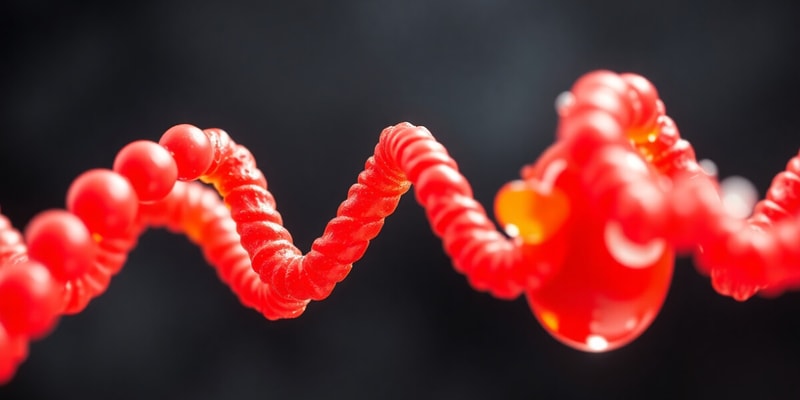Podcast
Questions and Answers
The equation for Gibbs Free Energy is ΔG = ΔH − TΔS, where ΔG represents the change in ______.
The equation for Gibbs Free Energy is ΔG = ΔH − TΔS, where ΔG represents the change in ______.
Gibbs Free Energy
For ATP conversion to ADP + Pi, the standard Gibbs Free Energy change (ΔG°) is ______ kJ mol−1.
For ATP conversion to ADP + Pi, the standard Gibbs Free Energy change (ΔG°) is ______ kJ mol−1.
-30.5
The enthalpy change (ΔH°) for the same reaction is ______ kJ mol−1.
The enthalpy change (ΔH°) for the same reaction is ______ kJ mol−1.
-20.1
At 37 °C, the calculated entropy change (ΔS°) for the reaction is ______ J mol−1.
At 37 °C, the calculated entropy change (ΔS°) for the reaction is ______ J mol−1.
Signup and view all the answers
For the unfolding of a protein, ΔH° is ______ kJ mol−1.
For the unfolding of a protein, ΔH° is ______ kJ mol−1.
Signup and view all the answers
The entropy change (ΔS°) for protein unfolding is ______ J K−1 mol −1.
The entropy change (ΔS°) for protein unfolding is ______ J K−1 mol −1.
Signup and view all the answers
To find the temperature at which the unfolding of a protein is spontaneous, we need to solve for ______ in the Gibbs Free Energy equation.
To find the temperature at which the unfolding of a protein is spontaneous, we need to solve for ______ in the Gibbs Free Energy equation.
Signup and view all the answers
For the unfolding to be spontaneous, ΔG must be ______.
For the unfolding to be spontaneous, ΔG must be ______.
Signup and view all the answers
Study Notes
Gibbs Free Energy
- Gibbs free energy (G) is a thermodynamic potential that can be used to predict the spontaneity of a process
- The change in Gibbs free energy (ΔG) is negative for spontaneous processes (favorable) and positive for non-spontaneous processes (unfavorable).
- ΔG = ΔH - TΔS where:
- ΔH: Change in enthalpy
- ΔS: Change in entropy
- T: Temperature in Kelvin
ATP Hydrolysis
- ATP hydrolysis (ATP → ADP + Pi) releases free energy, with a standard free energy change (ΔG°) of -30.5 kJ mol-1 at 37°C.
- The enthalpy change (ΔH°) of -20.1 kJ mol-1 indicates the process is exothermic (releases heat)
- The entropy change (ΔS°) is positive (+34.0 J mol-1) suggesting increased disorder when ATP is hydrolyzed into ADP and inorganic phosphate.
- The combination of negative enthalpy change and positive entropy change contributes to the highly negative free energy change, indicating the process is highly favorable.
Protein Unfolding
- Protein unfolding is the process where a protein loses its three-dimensional structure and becomes disordered.
- The enthalpy change (ΔH°) for protein unfolding is positive (250.8 kJ mol-1) indicating the process requires heat input (endothermic).
- The entropy change (ΔS°) for protein unfolding is also positive (752 J K-1 mol-1) indicating an increase in disorder as the protein unfolds.
- Protein unfolding becomes spontaneous above a certain temperature, because the positive entropy term becomes more dominant at high temperatures.
- This is because ΔG is negative for the unfolding process when TΔS > ΔH.
- The temperature at which protein unfolding becomes spontaneous is:
- Calculated by setting ΔG to 0 and rearranging the equation: T = ΔH/ ΔS
- This yields a temperature of approximately 333 K (60°C).
Studying That Suits You
Use AI to generate personalized quizzes and flashcards to suit your learning preferences.
Related Documents
Description
Test your understanding of Gibbs Free Energy, including its role in predicting spontaneity of processes. This quiz covers key concepts such as ATP hydrolysis and protein unfolding, with a focus on thermodynamic principles like enthalpy and entropy changes.




